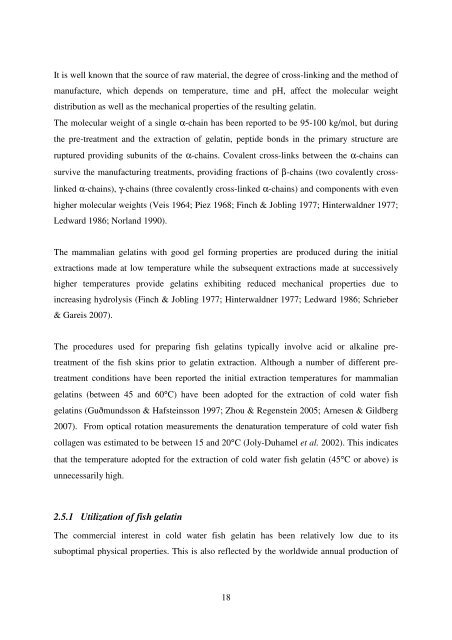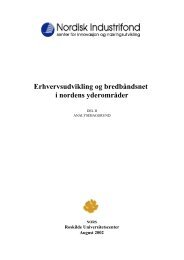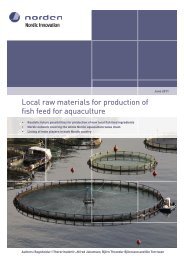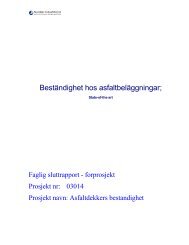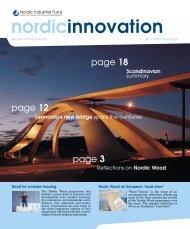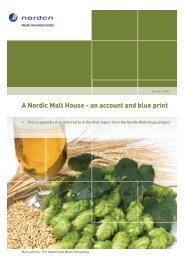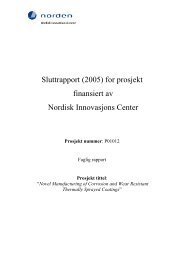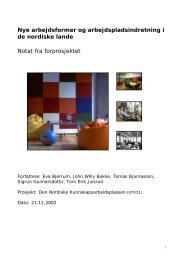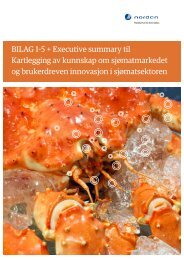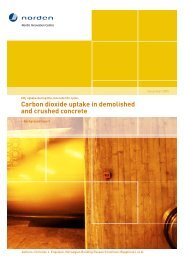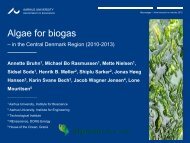Value added fish by-products - Nordic Innovation
Value added fish by-products - Nordic Innovation
Value added fish by-products - Nordic Innovation
Create successful ePaper yourself
Turn your PDF publications into a flip-book with our unique Google optimized e-Paper software.
It is well known that the source of raw material, the degree of cross-linking and the method of<br />
manufacture, which depends on temperature, time and pH, affect the molecular weight<br />
distribution as well as the mechanical properties of the resulting gelatin.<br />
The molecular weight of a single α-chain has been reported to be 95-100 kg/mol, but during<br />
the pre-treatment and the extraction of gelatin, peptide bonds in the primary structure are<br />
ruptured providing subunits of the α-chains. Covalent cross-links between the α-chains can<br />
survive the manufacturing treatments, providing fractions of β-chains (two covalently cross-<br />
linked α-chains), γ-chains (three covalently cross-linked α-chains) and components with even<br />
higher molecular weights (Veis 1964; Piez 1968; Finch & Jobling 1977; Hinterwaldner 1977;<br />
Ledward 1986; Norland 1990).<br />
The mammalian gelatins with good gel forming properties are produced during the initial<br />
extractions made at low temperature while the subsequent extractions made at successively<br />
higher temperatures provide gelatins exhibiting reduced mechanical properties due to<br />
increasing hydrolysis (Finch & Jobling 1977; Hinterwaldner 1977; Ledward 1986; Schrieber<br />
& Gareis 2007).<br />
The procedures used for preparing <strong>fish</strong> gelatins typically involve acid or alkaline pre-<br />
treatment of the <strong>fish</strong> skins prior to gelatin extraction. Although a number of different pre-<br />
treatment conditions have been reported the initial extraction temperatures for mammalian<br />
gelatins (between 45 and 60°C) have been adopted for the extraction of cold water <strong>fish</strong><br />
gelatins (Guðmundsson & Hafsteinsson 1997; Zhou & Regenstein 2005; Arnesen & Gildberg<br />
2007). From optical rotation measurements the denaturation temperature of cold water <strong>fish</strong><br />
collagen was estimated to be between 15 and 20°C (Joly-Duhamel et al. 2002). This indicates<br />
that the temperature adopted for the extraction of cold water <strong>fish</strong> gelatin (45°C or above) is<br />
unnecessarily high.<br />
2.5.1 Utilization of <strong>fish</strong> gelatin<br />
The commercial interest in cold water <strong>fish</strong> gelatin has been relatively low due to its<br />
suboptimal physical properties. This is also reflected <strong>by</strong> the worldwide annual production of<br />
18


